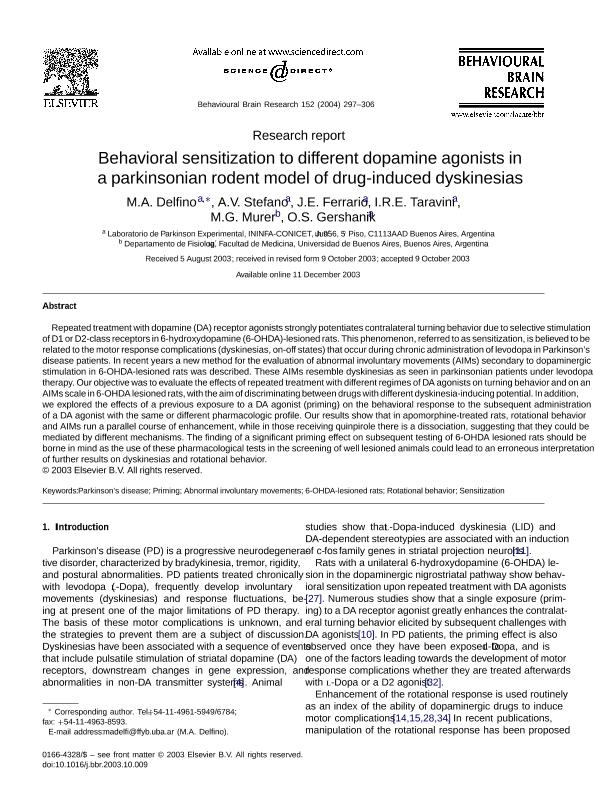Mostrar el registro sencillo del ítem
dc.contributor.author
Delfino, M.A.
dc.contributor.author
Stefano, A.V.
dc.contributor.author
Ferrario, Juan Esteban

dc.contributor.author
Taravini, Irene Rita Eloisa

dc.contributor.author
Murer, Mario Gustavo

dc.contributor.author
Gershanik, O.S.
dc.date.available
2020-01-10T20:25:24Z
dc.date.issued
2004-07
dc.identifier.citation
Delfino, M.A.; Stefano, A.V.; Ferrario, Juan Esteban; Taravini, Irene Rita Eloisa; Murer, Mario Gustavo; et al.; Behavioral sensitization to different dopamine agonists in a parkinsonian rodent model of drug-induced dyskinesias; Elsevier Science; Behavioural Brain Research; 152; 2; 7-2004; 297-306
dc.identifier.issn
0166-4328
dc.identifier.uri
http://hdl.handle.net/11336/94391
dc.description.abstract
Repeated treatment with dopamine (DA) receptor agonists strongly potentiates contralateral turning behavior due to selective stimulation of D1 or D2-class receptors in 6-hydroxydopamine (6-OHDA)-lesioned rats. This phenomenon, referred to as sensitization, is believed to be related to the motor response complications (dyskinesias, on-off states) that occur during chronic administration of levodopa in Parkinson’s disease patients. In recent years a new method for the evaluation of abnormal involuntary movements (AIMs) secondary to dopaminergic stimulation in 6-OHDA-lesioned rats was described. These AIMs resemble dyskinesias as seen in parkinsonian patients under levodopa therapy. Our objective was to evaluate the effects of repeated treatment with different regimes of DA agonists on turning behavior and on an AIMs scale in 6-OHDA lesioned rats, with the aim of discriminating between drugs with different dyskinesia-inducing potential. In addition, we explored the effects of a previous exposure to a DA agonist (priming) on the behavioral response to the subsequent administration of a DA agonist with the same or different pharmacologic profile. Our results show that in apomorphine-treated rats, rotational behavior and AIMs run a parallel course of enhancement, while in those receiving quinpirole there is a dissociation, suggesting that they could be mediated by different mechanisms. The finding of a significant priming effect on subsequent testing of 6-OHDA lesioned rats should be borne in mind as the use of these pharmacological tests in the screening of well lesioned animals could lead to an erroneous interpretation of further results on dyskinesias and rotational behavior.
dc.format
application/pdf
dc.language.iso
eng
dc.publisher
Elsevier Science

dc.rights
info:eu-repo/semantics/openAccess
dc.rights.uri
https://creativecommons.org/licenses/by-nc-sa/2.5/ar/
dc.subject
6-OHDA-LESIONED RATS
dc.subject
ABNORMAL INVOLUNTARY MOVEMENTS
dc.subject
PARKINSON'S DISEASE
dc.subject
PRIMING
dc.subject
ROTATIONAL BEHAVIOR
dc.subject
SENSITIZATION
dc.subject.classification
Otras Ciencias Médicas

dc.subject.classification
Otras Ciencias Médicas

dc.subject.classification
CIENCIAS MÉDICAS Y DE LA SALUD

dc.title
Behavioral sensitization to different dopamine agonists in a parkinsonian rodent model of drug-induced dyskinesias
dc.type
info:eu-repo/semantics/article
dc.type
info:ar-repo/semantics/artículo
dc.type
info:eu-repo/semantics/publishedVersion
dc.date.updated
2019-11-25T17:46:47Z
dc.journal.volume
152
dc.journal.number
2
dc.journal.pagination
297-306
dc.journal.pais
Países Bajos

dc.journal.ciudad
Amsterdam
dc.description.fil
Fil: Delfino MA. ININFA; Argentina. ININFA; Argentina
dc.description.fil
Fil: Stefano AV. ININFA; Argentina
dc.description.fil
Fil: Ferrario, Juan Esteban. ININFA; Argentina
dc.description.fil
Fil: Taravini, Irene Rita Eloisa. ININFA; Argentina
dc.description.fil
Fil: Murer, Mario Gustavo. FACULTAD DE MEDICINA; Argentina
dc.description.fil
Fil: Gershanik OS. ININFA; Argentina
dc.journal.title
Behavioural Brain Research

dc.relation.alternativeid
info:eu-repo/semantics/altIdentifier/url/https://www.sciencedirect.com/science/article/pii/S0166432803003735
dc.relation.alternativeid
info:eu-repo/semantics/altIdentifier/doi/http://dx.doi.org/10.1016/j.bbr.2003.10.009
Archivos asociados
